Brood Year 2019 Winter-Run Chinook Salmon Operations and Monitoring Assessment
The winter-run Chinook salmon in the Sacramento River is an endangered species, one of just nine species considered to be most at risk of near-term extinction and in need of urgent protection. Partnerships among federal, state, local, and tribal entities, together with non-governmental and private organizations, are key to restoring healthy salmon runs. Considering the cultural, economic, and environmental benefits salmon provide, implementing recovery actions is especially critical.
To support the implementation of future water management strategies in the Sacramento River, Anchor QEA used environmental, habitat, and biological data to assess the environmental conditions that influenced the 2019 brood year of the winter-run Chinook salmon. The assessment was conducted for the Sacramento River Science Partnership through funding provided by National Oceanic and Atmospheric Administration (NOAA) Fisheries.
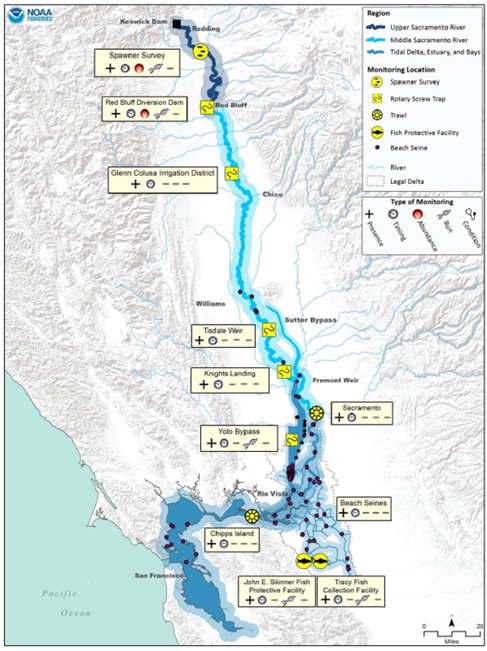
The assessment for the winter-run Chinook salmon focused on the upper and middle Sacramento River. The upper river runs from just below Keswick Dam to Red Bluff Diversion Dam (dark blue), and the middle river extends from Red Bluff to the Sacramento-San Joaquin River Delta entry point at Sherwood Harbor near Sacramento (light blue). Figure taken from Windell et al. 2017.
Assessing Habitat Conditions and Environmental Drivers in the Sacramento River
Fish are influenced by multiple environmental and habitat conditions that are controlled in part by water management operations. Anchor QEA’s assessment used conceptual models that were developed as part of the Salmon Assessment of Indicators by Life Stage (SAIL)—an effort to characterize specific environmental and management factors that drive the winter-run Chinook salmon biological responses within discrete geographic domains and life stages.
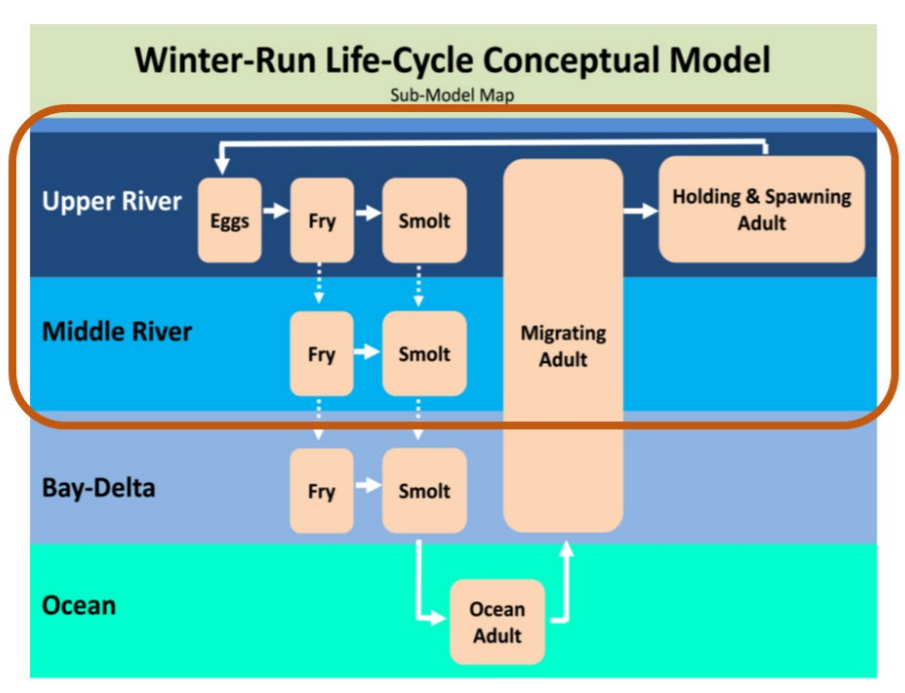
Anchor QEA’s assessment emphasized life stages in the middle and upper river, as shown in the Sacramento River Winter-Run Life-Cycle Conceptual Model of different life stages and geographic domains. Figure taken from Windell et al. 2017.
Hierarchical tiers created within this conceptual model described the environmental pathways that affect each life stage within a geographic domain, including landscape and habitat attributes and environmental drivers, and fish responses such as survival, timing, migration, condition, and growth. The assessment framework identified numerous variables with the potential to affect winter-run Chinook salmon survival and productivity, focusing on freshwater life stages including adult spawning and egg-to-fry survival in the upper Sacramento River and juvenile rearing and out-migration through the river’s upper and middle sections.
Adult Spawning
Anchor QEA evaluated the environmental and habitat conditions experienced by adults returning to the upper Sacramento River from January through September 2019, which includes the period when adults hold and spawn in the river. The results were favorable, with 7,852 mainstem in-river spawners—the highest escapement (survival) since 2006—and low pre‑spawn mortality. Water management decisions such as when to store and when to release water from Shasta Lake led to optimal flows in the river that created the maximum spawning habitat and met the water temperature criterion for the spawning season. Given these beneficial flows and temperatures, the estimated hatchery influence on the spawning population was higher than expected. To maintain the health and genetic diversity of the natural population of winter-run Chinook salmon, it is important that the influence of hatchery-raised fish not be too high.
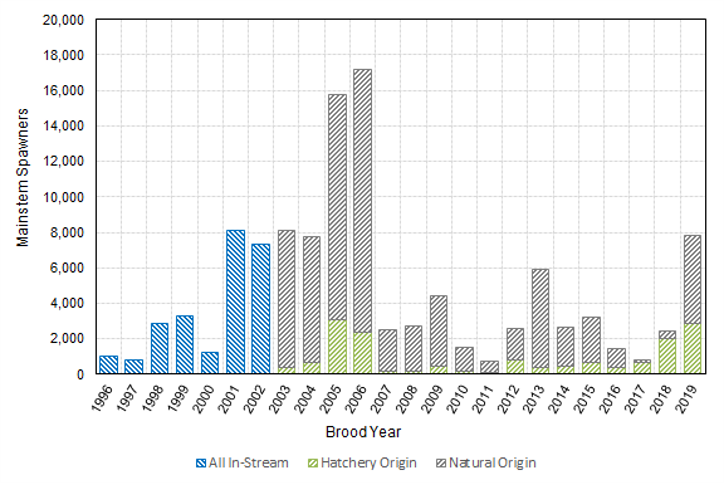
This graphic shows the estimated total mainstem in-river spawners of natural and hatchery origin. All in-river spawners are shown in blue for years 1996 to 2002. Natural-origin spawners (grey) and hatchery-origin spawners (green) are shown for 2003 to 2019.
Egg-to-Fry Emergence and Survival
Our evaluation of eggs and juveniles in the upper Sacramento River from June 2019 through March 2020 found that water management operations supported an abundance of fry (recently hatched or juvenile fish), despite lower than average egg-to-fry survival, due to the large number of eggs produced by adults. This encompassed the portion of the life cycle beginning with redd (salmon nest) occupation until juvenile migrants were no longer observed passing through the Red Bluff Diversion Dam monitoring location. The lower than average egg-to-fry survival was likely related to density dependence and other factors that were not evaluated, considering that flows, temperature, and dissolved oxygen conditions were beneficial in 2019.
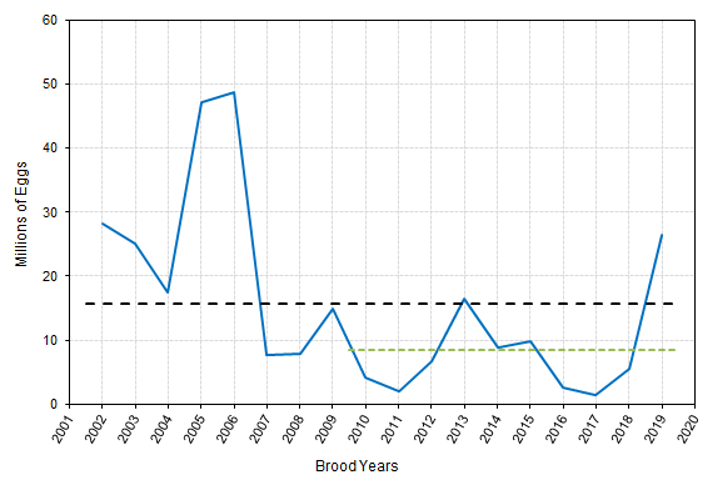
The total number of eggs (blue line) in the upper Sacramento River was higher than the 10-year (green) and 20-year (black) averages due to the large escapement, and beneficial habitat attributes and environmental drivers. However. egg-to-fry survival was not better than the 10-year average.
Rearing-to-Out-Migrating Juveniles in the Upper and Middle Sacramento River
The conditions provided by the 2019 to 2020 water management operations had a positive effect on rearing-to-out-migrating juvenile fish in the upper Sacramento River. Water management pulse flows were provided but did not appear to stimulate earlier juvenile movement downstream, as the median date of passage through the upper Sacramento River was only slightly earlier than average. However, passage through the middle Sacramento River was earlier than the 10-year average at Knights Landing and substantially earlier at Sherwood Harbor, based on using body length to determine winter run Chinook salmon passage. Environmental conditions in the middle Sacramento River—including water temperature, turbidity, system hydrology, and migration cues—proved beneficial for productivity, benefiting rearing and out-migrating juveniles. However, the winter flows were low, similar to previous years and juveniles could not access floodplains and take advantage of the resources and benefits provided by these habitats.
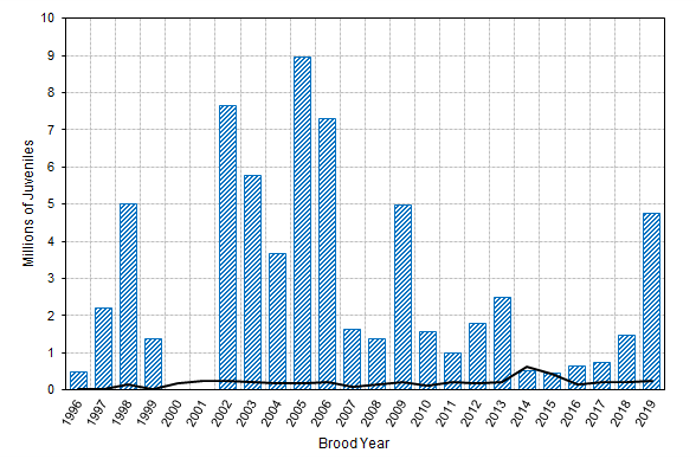
The blue bars show that the number of natural-origin juveniles in the upper Sacramento River was much greater than the number of hatchery released juveniles (black line) for brood-year 2019. The overall habitat conditions evaluated were better than average or expected to benefit rearing and out-migrating juveniles, indicating positive results for juveniles rearing in and out-migrating from the upper Sacramento River.
Ultimately, our 2019 assessment of the environmental conditions, water management operations, habitat attributes, and fish responses through each life stage generally showed positive results along the Sacramento River. The SAIL Conceptual Model provided an effective framework to assess the relative success by providing life-stage-specific hypotheses on how fish responses are influenced by environmental and habitat conditions that are controlled in part by water management operations and optimal flows.
Repeating this assessment annually could inform adjustments in water management operations that would benefit the winter-run Chinook salmon. In addition, annual assessments would provide a time series for trend analyses of population variability. With favorable responses to the 2019 to 2020 water management actions, the winter-run Chinook salmon population appears to be recovering from the drought years and is showing signs of improved viability. Complete results are available in the paper “Brood Year 2019 Winter-Run Chinook Salmon Operations and Monitoring Assessment,” prepared by Anchor QEA, LLC for NOAA Fisheries.

